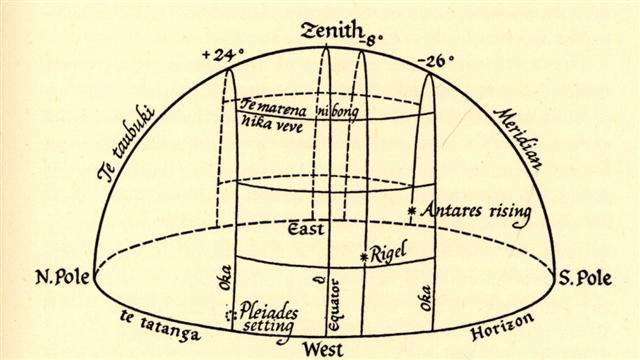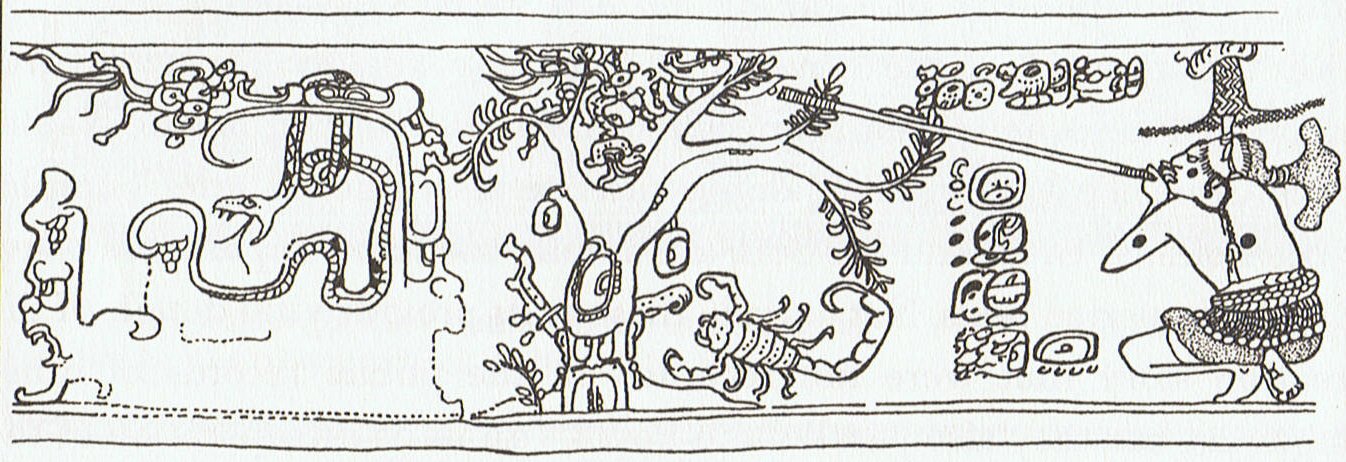|
TRANSLATIONS
I do not share the view in Maya Cosmos that the rattlesnake constellation is Sagittarius. I think it is the Pleiades:  With the scorpion constellation = Antares and surrounding stars (26º S), the other side of the 'tree' ought to be the Pleiades. After the spring snake comes the midsummer tree and then Scorpio will come. The Maya indians read from left to right. Connected with the snake there is even a suggestion of a great mountain with Janus faces. At 'dawn' the serpent comes out from his hole, according to belief in ancient Egypt. Interestingly in Polynesia the 'snake' (eel) does the opposite - eels do not like the sun and go into hiding at dawn. South of the equator it is Scorpio who announces 'dawn', not the Pleiades. Furthermore, I remember having read somewhere that the Pleiades constellation was identified with a rattle (because of the small 'seeds' seen in the constellation, like the seeds in a rattle). "The Indians of Middle America recognized a curious cycle of fifty-two years, whose beginning and end were marked by the midnight culmination of the Pleiades. They believed that upon the completion of one of these cycles the world was to be instantaneously demolished. On the night which closed such a period they extinguished all fires and kept anxious vigil from sunset until the Pleiades had safely crossed the meridian. Then, the danger of annihilation having been deferred for another fifty-two years at least, they kindled new fires in all the villages and celebrated a general feast of thanksgiving. On the same date the Sun entered the zodiacal sign of the dead, symbolizing death and the renewal of life." (Makemson) What better symbol for death than a rattle-snake? And the snake is able to renew himself by shedding his old skin. "Throughout the American continents the Pleiades cluster was associated with the food supply. It was known to the Eskimo as Sharing-out-of-food and to the ancient Peruvians as the Granary. There is a widespread Indonesian legend that rice was first obtained from the Pleiades." (Makemson) The little seeds (the Pleiades) of course come from the dead old plant. By rattling them in a rattle they will come awake and give new life. The 'small eyes' (Matari'i) will give life. While searching in Makemson for the rattle = the Pleiades I found another useful item: "The twenty-seventh and twenty-eighth nights of the Moon were [on Tahiti] sacred to Tane and Rongo respectively and the Maori planted their sweet potatoes on these nights in the appropriate month. Although they occured in the dark of the Moon or waning crescent phase, these nights were termed Great-Tane-of-the-light and Great-Rongo-of-the-light by the Central Polynesians. The twenty-ninth night was also dedicated to Rongo and was known as Sacred Rongo (Ro'omauri), and the thirtieth night was motu, 'cut off'. The word motu or moku recalls a curious Hawaiian tale in which Hina, who was the wife of Makalii (Pleiades) or, as some say, of Aikanaka, Man-eater, fell in love with the Moon and decided to go to it. Just as she was about to ascend beyond reach her husband seized her leg and twisted it so violently that he broke it. Hina, however, reached the Moon and immediately changed her name to Lono-moku, Crippled Lono (Rongo). An exchange of sexes seems to [be] indicated in the change of name." (Makemson) The cut off leg (vae) - or at least broken leg - at the end of the year was twisted. Janus has to turn 180º and that happens both at winter solstice and at new moon. The 'twister' god has given his name to the first night in the moon calendar, Ohiro:
When that happens, at solstice and at new moon (or at full moon) a change of sexes takes place. Omotohi (15) is not far away from ko-motu-hi(na), the crippling of moon. His 'head' starts to roll down the mountain slope. The new moon (and - presumably - new sun) 'babies' are born following the arrival of the water: ... When Hotu's canoe had reached Taharoa, the vaginal fluid (of Hotu's pregnant wife) appeared. They sailed toward Hanga Hoonu, where the mucus (kovare seems to refer to the amniotic sac in this case) appeared. They sailed on and came to Rangi Meamea, where the amniotic fluid ran out and the contractions began ... Next page in the glyph dictionary:
|
|||||||||||||||||||||||||||||||||||||||||||||||||||||||||||||||||||||||||||||||||||||||||||||||||||||||||||||||||||||||||||||||||||||||||||||||||||||||||||||||||||||||||||||











